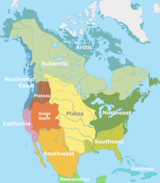Arlington Springs Man
The Arlington Springs man is a set of Late Pleistocene human remains discovered in 1959 on Santa Rosa Island, one of the Channel Islands located off the coast of Southern California. The Arlington Springs archeological site is protected within northern Channel Islands National Park, and in Santa Barbara County.
History
Archaeology
In 1959–1960, two femora were excavated by Phil C. Orr, curator of anthropology and paleontology at the Santa Barbara Museum of Natural History, at Arlington Springs on Santa Rosa Island. Orr believed the remains were those of a 10,000-year-old man and dubbed them the "Arlington Springs Man".[1]
The Arlington Springs Man was later re-examined in 1989 by Orr's successors at the museum, Dr. John R. Johnson and Don Morris. The two came to the initial assessment that the Arlington Springs Man was actually the "Arlington Springs Woman". Radiocarbon dating determined that the remains dated to 13,000 years BP,[2] making the remains potentially the oldest-known human skeleton in North America.[3] The term "Arlington Springs Woman" was used at that time to refer to these remains.[4]
After further study, Johnson reversed his sex assessment in 2006, concluding that the remains were more likely those of a man, and the name "Arlington Springs Man" was again the more appropriate name.[5]
Geology
The Paleoindian Arlington Springs Man lived on the former Pleistocene epoch Santa Rosae island. During the last ice age, the four northern Channel Islands were held together as the one mega-island of Santa Rosae.
The weather was much cooler and the sea level was 150 feet (46 m) lower than today. His presence on an island at such an early date demonstrates that the earliest Paleoindians had watercraft capable of crossing the Santa Barbara Channel, and lends credence as well to a "coastal migration" theory for the peopling of the Americas, using boats to travel south from Siberia and Alaska.[6]
See also
- Buhl Woman – (Human remains)
- Calico Early Man Site – (Archeological site)
- Cueva de las Manos – (Cave paintings)
- Fort Rock Cave – (Archeological site)
- Kennewick Man – (Human remains)
- Kwäday Dän Ts'ìnchi – (Human remains)
- List of unsolved deaths
- Marmes Rockshelter – (Archeological site)
- Paisley Caves – (Archeological site)
- Peñon woman – (Human remains)
References
- ^ Orr, PhilOrr, Phil C. (1962). "Arlington springs man". Science. 135 (3499): 219. Bibcode:1962Sci...135..219O. doi:10.1126/science.135.3499.219. PMID 14482348. S2CID 8736053.
{{cite journal}}: CS1 maint: multiple names: authors list (link) - ^ Glassow, Michael A. (editor), Todd J. Braje, Julia G. Costello, Jon M. Erlandson, John R. Johnson, Don P. Morris, Jennifer E. Perry, and Torben C. Rick (2014), Technical report. Channel Islands National Park Archaeological Overview and Assessment.
- ^ Polokavic, Gary (11 April 1999). "Channel Island Woman's Bones May Rewrite History". Los Angeles Times. Retrieved 28 March 2015.
- ^ "Arlington Springs Woman biography | birthday, trivia | American Ancient Human". Who2. Retrieved 2020-09-29.
- ^ Chawkins, Steve (11 September 2006). "Ancient Bones Belonged to a Man – Probably". Los Angeles Times. Retrieved 28 March 2015.
- ^ Johnson, Dr. John R. "Arlington Man". Channel Islands. National Park Service. Retrieved 28 March 2015.
External links
- NPS.gov: Channel Islands National Park — Arlington Man
- About.com: Arlington Springs Site
- Journal from The Center for the Study of the First Americans: "The Mammoth Trumpet" — Volume 21, Number 4 September 2006.
"Santa Barbara County, California" is an invalid category parameter for Template:Coord missing.
The problem is usually caused either by a spelling mistake or by an-over-precise category.
For a full list of categories, see Category:Unclassified articles missing geocoordinate data and its subcategories.
- Santa Barbara County, California articles missing geocoordinate data
- 1959 archaeological discoveries
- 1959 in California
- Archaeological sites in California
- Channel Islands National Park
- History of Santa Barbara County, California
- Indigenous peoples of California
- Late Pleistocene
- Native American history of California
- Natural history of the Channel Islands of California
- Oldest human remains in the Americas
- Paleo-Indian period
- Pleistocene California
- Pre-statehood history of California
- Unsolved deaths

